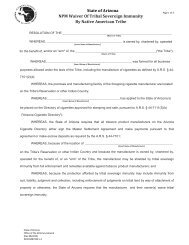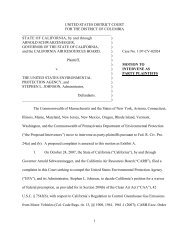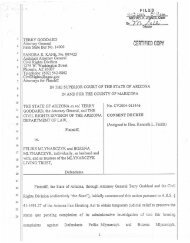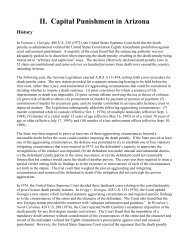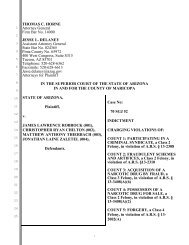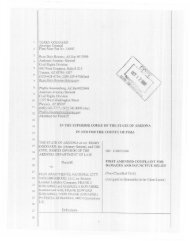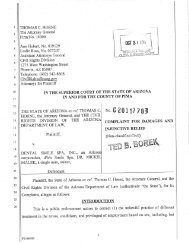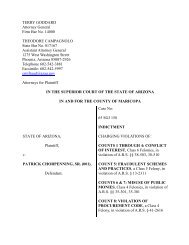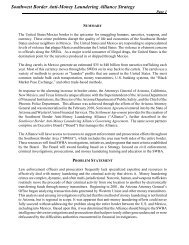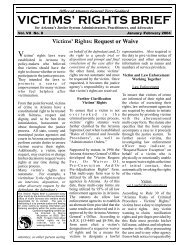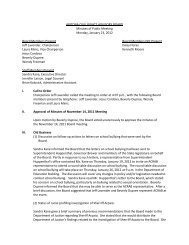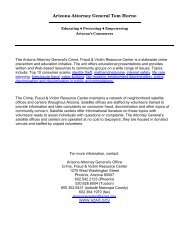2010 Arizona Youth Survey - Arizona Attorney General
2010 Arizona Youth Survey - Arizona Attorney General
2010 Arizona Youth Survey - Arizona Attorney General
You also want an ePaper? Increase the reach of your titles
YUMPU automatically turns print PDFs into web optimized ePapers that Google loves.
Risk and Protective Scale Definitions<br />
Table 3. Scales that Measure the Risk and Protective Factors Shown in the Profiles<br />
School Domain Protective Factors<br />
1<br />
Opportunities for Prosocial<br />
Involvement<br />
1<br />
Rewards for Prosocial<br />
Involvement<br />
When young people are given more opportunities to participate meaningfully in important activities at school, they are<br />
less likely to engage in drug use and other problem behaviors.<br />
When young people are recognized and rewarded for their contributions at school, they are less likely to be involved in<br />
substance use and other problem behaviors.<br />
Peer-Individual Risk Factors<br />
1<br />
1<br />
1<br />
1<br />
Rebelliousness<br />
Early Initiation of Antisocial<br />
Behavior and Drug Use<br />
Young people who do not feel part of society, are not bound by rules, don’t believe in trying to be successful or<br />
responsible, or who take an active rebellious stance toward society, are at higher risk of abusing drugs. In addition,<br />
high tolerance for deviance, a strong need for independence and normlessness have all been linked with drug use.<br />
Early onset of drug use predicts misuse of drugs. The earlier the onset of any drug use, the greater the involvement in<br />
other drug use and the greater frequency of use. Onset of drug use prior to the age of 15 is a consistent predictor of<br />
drug abuse, and a later age of onset of drug use has been shown to predict lower drug involvement and a greater<br />
probability of discontinuation of use.<br />
1<br />
Attitudes Favorable Toward<br />
Antisocial Behavior and Drug Use<br />
During the elementary school years, most children express anti-drug, anti-crime, and pro-social attitudes and have<br />
difficulty imagining why people use drugs or engage in antisocial behaviors. However, in middle school, as more youth<br />
are exposed to others who use drugs and engage in antisocial behavior, their attitudes often shift toward greater<br />
acceptance of these behaviors. <strong>Youth</strong> who express positive attitudes toward drug use and antisocial behavior are more<br />
likely to engage in a variety of problem behaviors, including drug use.<br />
1<br />
Perceived Risk of Drug Use<br />
1<br />
Interaction with Antisocial Peers<br />
1<br />
Friends' Use of Drugs<br />
1<br />
Rewards for Antisocial Behavior<br />
1<br />
1<br />
Gang Involvement<br />
Young people who do not perceive drug use to be risky are far more likely to engage in drug use.<br />
Young people who associate with peers who engage in problem behaviors are at higher risk for engaging in antisocial<br />
behavior themselves.<br />
Young people who associate with peers who engage in alcohol or substance abuse are much more likely to engage in<br />
the same behavior. Peer drug use has consistently been found to be among the strongest predictors of substance use<br />
among youth. Even when young people come from well-managed families and do not experience other risk factors,<br />
spending time with friends who use drugs greatly increases the risk of that problem developing.<br />
Young people who receive rewards for their antisocial behavior are at higher risk for engaging further in antisocial<br />
behavior and substance use.<br />
<strong>Youth</strong> who belong to gangs are more at risk for antisocial behavior and drug use.<br />
Peer-Individual Protective Factors<br />
1<br />
Belief in the Moral Order<br />
1<br />
Interaction with Prosocial Peers<br />
1<br />
Prosocial Involvement<br />
1<br />
Rewards for Prosocial<br />
Involvement<br />
Young people who have a belief in what is “right” or “wrong” are less likely to use drugs.<br />
Young people who associate with peers who engage in prosocial behavior are more protected from engaging in<br />
antisocial behavior and substance use.<br />
Participation in positive school and community activities helps provide protection for youth.<br />
Young people who are rewarded for working hard in school and the community are less likely to engage in problem<br />
behavior.<br />
40



